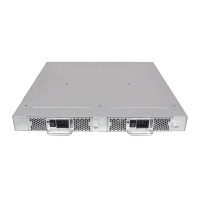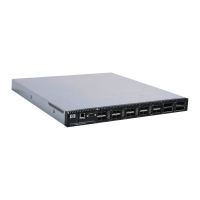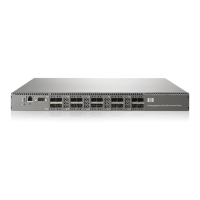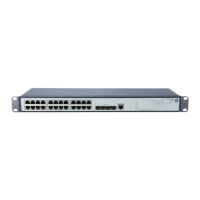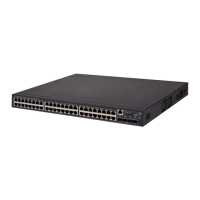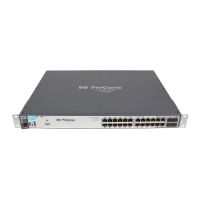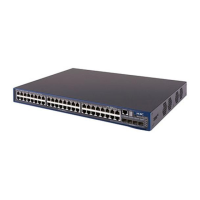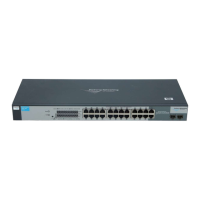Fabric OS Administrator’s Guide 447
53-1002446-01
Configuring F_Port trunking for Access Gateway
22
F_Port trunking in Virtual Fabrics
F_Port trunking functionality performs the same in Virtual Fabrics as it does in non-virtual fabric
platforms except for the Brocade DCX and DCX 8510-8. Fabric OS uses a 10-bit addressing model,
which is the default mode for all dynamically created logical switches in the DCX platform.
In the DCX and DCX 8510 platforms, F_Port trunk ports dynamically receive an 8-bit area address
that remains persistent. After F_Port trunking configurations are removed from a port in a logical
switch, that port returns to the default 10-bit area address model, which supports up to 1024
F_Ports in a logical switch.
Because the DCX and DCX 8510-8 platforms have a maximum of 576 ports, out of the 1024 10-bit
address range, addresses 448-1023 are reserved for the 10-bit address space. Addresses 0–447
are reserved for assigning to NPIV/Loop ports to support 112 [448/4] NPIV/Loop ports in a logical
switch with 256 devices each.
Following are the F_Port trunking considerations for virtual fabrics:
• If a port is enabled for F_Port trunking, then you must disable the configuration before you can
move a port from the logical switch.
• If the user bound area for a port is configured using the portAddress command, then the port
cannot be configured as an F_Port trunk port. You must explicitly remove the user bound area
before enabling F_Port trunking.
• If you swap a port using the portSwap command, then you must undo the port swap before
enabling F_Port trunking.
• The Port WWN format in a Virtual Fabric is 2z:zz:xx:xx:xx:xx:xx:xx. The z:zz is the logical port
number, for example, the logical port 450 will be 1:c2. The xx:xx:xx:xx:xx:xx is based on the
logical fabric WWN.
For example, if the logical fabric WWN is 10:00:00:05:1e:39:fa:f3, and logical port number is
450, then the Port WWN of the F_Port trunk will be 21:c2: 00:05:1e:39:fa:f3.
• F_Port trunks are not allowed on the base switch because you cannot have F_Ports on the
base switch.
• If F_Port trunking is enabled on some ports in the default switch, and you disable Virtual
Fabrics, all of the F_Port trunking information is lost.
• All of the ports in an F_Port trunk must belong to a single trunk group of ports on the platform
and must also belong to the same logical switch.
See Chapter 10, “Managing Virtual Fabrics,” for detailed information about Virtual Fabrics.
Configuring F_Port trunking for Access Gateway
Access Gateway trunking configuration is mostly on the edge switch. On the Access Gateway
module, you only need to ensure that the trunking license is applied and enabled.
Perform the following procedure on the edge switch connected to the Access Gateway module.
1. Connect to the switch and log in using an account assigned to the admin role.
2. Enter the portCfgShow command to ensure that the ports have trunking enabled. If trunking is
not enabled, enter the portCfgTrunkPort port 1 command.
